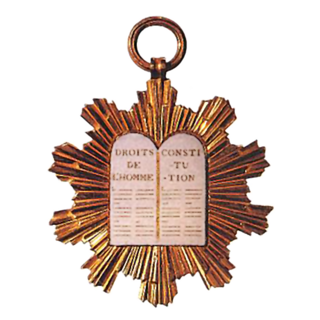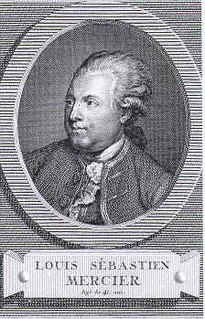
The Reign of Terror, commonly The Terror, was a period of the French Revolution when, following the creation of the First French Republic, a series of massacres and numerous public executions took place in response to revolutionary fervour, anticlerical sentiment, and accusations of treason by the Committee of Public Safety.
Millenarianism, from Latin mīllēnārius "containing a thousand", is the belief by a religious, social, or political group or movement in a coming fundamental transformation of society, after which "all things will be changed". Millenarianism exists in various cultures and religions worldwide, with various interpretations of what constitutes a transformation.

Encyclopédie, ou dictionnaire raisonné des sciences, des arts et des métiers, better known as Encyclopédie, was a general encyclopedia published in France between 1751 and 1772, with later supplements, revised editions, and translations. It had many writers, known as the Encyclopédistes. It was edited by Denis Diderot and, until 1759, co-edited by Jean le Rond d'Alembert.

The Legislative Assembly was the legislature of France from 1 October 1791 to 20 September 1792 during the years of the French Revolution. It provided the focus of political debate and revolutionary law-making between the periods of the National Constituent Assembly and of the National Convention.

Louis-Sébastien Mercier was a French dramatist and writer, whose 1771 novel L'An 2440 is an example of proto-science fiction.

Robert Choate Darnton is an American cultural historian and academic librarian who specializes in 18th-century France.

Thérèse Philosophe is a 1748 French novel ascribed to Jean-Baptiste de Boyer, Marquis d'Argens. It has been chiefly regarded as a pornographic novel, which accounts for its massive sales in 18th-century France. Aside from that however, this novel represents a public conveyance for some ideas of the Philosophes.

Julie; or, The New Heloise, originally entitled Lettres de Deux Amans, Habitans d'une petite Ville au pied des Alpes, is an epistolary novel by Jean-Jacques Rousseau, published in 1761 by Marc-Michel Rey in Amsterdam.
David Denby was an author and a senior lecturer in French at Dublin City University. He retired in 2010.

The Great Cat Massacre and Other Episodes in French Cultural History is an influential collection of essays on the cultural history of early modern France by the American historian Robert Darnton, first published in 1984. The book's title is derived from its most famous chapter which describes and interprets an unusual source detailing the "massacre" of cats by apprentice printers living and working on Rue Saint-Séverin in Paris during the late 1730s. Other chapters look at fairy tales, the writing of the Encyclopédie and other aspects of French early modern history.
A libelle is a political pamphlet or book which slanders a public figure. Libelles held particular significance in France under the Ancien Régime, especially during the eighteenth century, when the pamphlets’ attacks on the monarchy became both more numerous and venomous. In recent years, cultural historian Robert Darnton has written on the libelles, arguing for the subversive power that the libelles of the late eighteenth century exercised in undermining monarchical authority.
This article focuses on Grub Street in France.
The Société typographique de Neuchâtel was a Swiss publishing house and bookseller that operated between 1769-1794. Their archives, consisting of around 25,000 letters and various types of account books held in the Bibliothèque publique et universitaire de Neuchâtel, are an unparalleled source for the study of the eighteenth-century European book trade. The STN published over 220 works, over 500 volumes in total, the majority of which were counterfeit editions. Clients included Jacques Garrigan; Perisse Frères; Rigaud, Pons & Compagnie; and Luke White.
Clandestine literature, also called "underground literature", refers to a type of editorial and publishing process that involves self-publishing works, often in contradiction with the legal standards of a location. Clandestine literature is often an attempt to circumvent censorship, prosecution, or other suppression. In academic study, such literature may be referred to as heterodox publications.

Symbolism in the French Revolution was a device to distinguish and celebrate the main features of the French Revolution and ensure public identification and support. In order to effectively illustrate the differences between the new Republic and the old regime, the leaders needed to implement a new set of symbols to be celebrated instead of the old religious and monarchical symbolism. To this end, symbols were borrowed from historic cultures and redefined, while those of the old regime were either destroyed or reattributed acceptable characteristics. New symbols and styles were put in place to separate the new, Republican country from the monarchy of the past. These new and revised symbols were used to instill in the public a new sense of tradition and reverence for the Enlightenment and the Republic.
The Enfer is a special department of the Bibliothèque nationale de France in Paris. It is a special collection of books and manuscripts of an erotic or pornographic character which, because of their rarity and value, may be seen only with authorization. The Enfer was established 1836–1844 and is one of the most famous Private Case collections. In 2013, the Enfer contained about 2,600 volumes, dating from the 16th century to the present.

Journal of My Life is an autobiography by Jacques-Louis Ménétra, an eighteenth-century master glazier in Paris. Begun in 1764, when Ménétra returned from a journeyman's tour of the French provinces, Ménétra's text intersperses accounts of his life on the road and in Paris with tall tales, braggadocio, jokes, and accounts of his seductions and pranks. In the words of historian Robert Darnton, Ménétra's narrative "restores the human dimension to the study of social conditions and brings flesh and blood to lifeless sociological categories. What we can finally see, with the help of these memoirs, is ordinary, everyday life."
The Lyell Readership in Bibliography is an endowed annual lecture series given at Oxford University. Instituted in 1952 by a bequest from the solicitor, book collector and bibliographer James Patrick Ronaldson Lyell (1871–1948), the series has continued down to the present day. Together with the Panizzi Lectures at the British Library and the Sandars Lectures at Cambridge University, it is considered one of the major British bibliographical lecture series.

L'An 2440, rêve s'il en fut jamais is a 1771 novel by Louis-Sébastien Mercier.
As of 2018, five firms in France rank among the world's biggest publishers of books in terms of revenue: Éditions Lefebvre Sarrut, Groupe Albin Michel, Groupe Madrigall, Hachette Livre, and Martinière Groupe.











